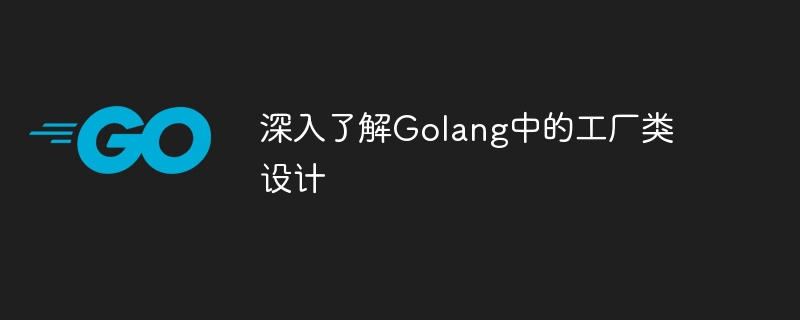Home >Backend Development >Golang >In-depth understanding of factory class design in Golang
In-depth understanding of factory class design in Golang
- 王林Original
- 2024-04-03 16:09:02505browse
Factory class is a design pattern in Golang that is used to create a unified interface for objects and separate creation logic and client code. It provides the following advantages: Separation of creation logic Extensibility Reduces code redundancy Factory classes are suitable for use when you need to create different types of objects, the creation process is complex, or when you need to centralize object creation.

In-depth factory class design in Golang
In Golang, the factory class is a design pattern that provides the ability to create A unified interface for objects, thereby avoiding the specific details of creating objects. It allows us to separate object creation logic from client code by providing a method for creating objects.
Factory Class Example
Let’s write a sample factory class to create different shapes:
package main
import "fmt"
type Shape interface {
Draw()
}
type Circle struct{}
func (c *Circle) Draw() {
fmt.Println("Drawing a circle")
}
type Square struct{}
func (s *Square) Draw() {
fmt.Println("Drawing a square")
}
type ShapeFactory struct{}
func (f *ShapeFactory) CreateShape(shapeType string) (Shape, error) {
switch shapeType {
case "circle":
return &Circle{}, nil
case "square":
return &Square{}, nil
default:
return nil, fmt.Errorf("Invalid shape type: %s", shapeType)
}
}
func main() {
factory := ShapeFactory{}
circle, err := factory.CreateShape("circle")
if err != nil {
fmt.Println(err)
return
}
circle.Draw()
square, err := factory.CreateShape("square")
if err != nil {
fmt.Println(err)
return
}
square.Draw()
}Practical Case
In actual applications, the factory class can be used in the following scenarios:
- Create different types of database connections
- Create different types of file readers/writers
- Create different types of loggers
Advantages
- Separate creation logic: Factory Classes isolate the process of creating objects, allowing creation logic to be changed without affecting client code.
- Extensibility: Factory classes can be easily extended to support new object types by adding new creation methods.
- Reduce code redundancy: Factory classes can reduce repeated code for creating objects, making the code clearer and more maintainable.
When to use factory classes?
- When you need to create objects of different types.
- When the process of creating an object is complex or error-prone.
- When you need to control and centralize object creation.
The above is the detailed content of In-depth understanding of factory class design in Golang. For more information, please follow other related articles on the PHP Chinese website!

